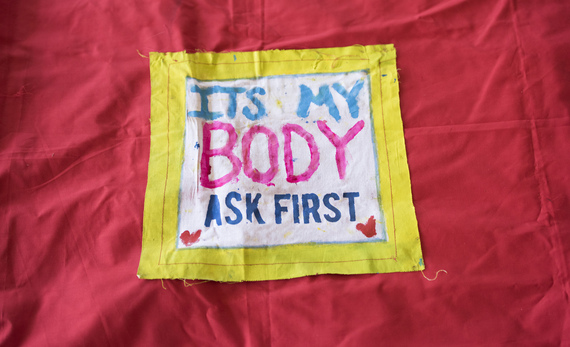
by Sarah Marcantonio, a student at Emerson University in Boston, with additional reporting from Em & Lo
Consent (noun): Permission, approval or agreement.
Here's my definition of sexual consent: two (or more) people actively, explicitly and consciously agreeing to have sexual interactions throughout those interactions, with no party having any reservations at any point. I was taught, both in high school in New Jersey and here at Emerson College, that "Only yes means yes," so a lack of "No" cannot be taken as consent.
Fortunately, more and more people my age share this understanding of the concept of consent, thanks to recent media coverage of the epidemic of college sexual assault and various efforts to stop it:
- The 2015 Association of American Universities (AAU) Report, which found that 21.2 percent of seniors from 27 colleges were victims of nonconsensual sexual contact (sexual touching and/or penetration) from either physical force, threat of physical force, incapacitation, coercion, or absence of affirmative consent. For just women, the number was 33.1 percent.
- NotAlone.gov, President Obama's first White House task force on college sexual assault launched in January 2014, which released it's first report in April of 2014 on best practices for students and administrators to protect students from sexual assault
- Know Your IX, a survivor- and youth-led organization founded in 2013 that "aims to empower students to end sexual and dating violence in their schools"
- The Monument Quilt, a "public healing space by and for survivors of rape and abuse," which collects stories from survivors to demonstrate how sexual violence occurs to many different people in many different ways
- The Hunting Ground, the award-winning 2015 documentary on rape culture on campuses, which included the Oscar-nominated song by Lady Gaga, "Til It Happens to You"
- ItsOnUs.org, a campaign aimed at engaging college students and all members of campus communities in preventing sexual assault in the first place, with an emphasis on male bystander responsibility
- "What If Bears Killed 1 in 5 People," the viral PSA made by Funny or Die in conjunction with It's On Us, illustrating how widespread sexual assault is not something you should sit by and idly watch happen
Some have taken issue with the "1 in 5" stat often used, siting the infamous Rolling Stone article on an alleged campus gang rape that was based on false allegations, or the fact that the AAU study might have suffered a non-reporting bias (i.e. people who haven't been assaulted might be less likely to fill out this kind of survey), or that the study's authors emphasize that this is not necessarily nationally representative, or that acts simply without affirmative consent were included. But if you only account for nonconsensual penetration or sexual touching by force or incapacitation -- what some might consider "legitimate rape" -- the number is still a scary 11.7 percent. Whether it's 1 in 10 or 1 in 20 or 1 in 50, it's too many, especially at institutions of higher learning where students are supposed to be becoming better citizens. Talk to any woman or gender non-conforming person, and there's no denying that sexual assault -- from unwanted sexual touching over clothes to oral, anal or vaginal rape -- happens in mystifying numbers, both on and off campus.
In an effort to get a sense of how well -- or not -- American colleges are currently dealing with this issue, I conducted an informal online survey of 46 friends and friends of friends from at least 19 colleges* across the nation (5 responses were anonymous). Here are my conclusions:
- Most young adults are learning about consensual sex during first year orientation for college. In 2010, the U.S. government reported that over 40% of teens in the United States are having sex. But most teens don't start learning about consent until years after they are first taught about sex, indeed years after they first have sex. For most, it's not until college orientation when the concept arises concretely. While consent education does fortunately happen in some high schools, several college students said there was no "full explanation" until college and the previous definitions given were "wishy-washy."
- Sex-related orientation programs and sections of student handbooks are the rule now. Though they vary from school to school, almost all colleges include a section of the student handbook dedicated to sexual misconduct, Title IX policies, definitions of sexual assault and harassment, and some information on what punishments might be for misconduct. Consent, assault, and harassment are discussed during most, but not all, first year orientations in some format -- some have a quick assembly featuring a speaker from outside the college while some have an entire department devoted to these cases.
- Religious institutions are generally not great on consent. Religious institutions, which usually advocate for abstinence until marriage, don't often tackle rape and assault, which belies their misconceptions that young people don't have sex, the devout are incapable of rape, and wishing for something makes it so. "There wasn't much [on consent] because we were taught to be abstinent until marriage," said one Brigham Young University student in Utah. The student handbook of Loyola University Maryland, a private Catholic university, includes the line "if you believe [our emphasis] that you have been the victim of sexual misconduct...," suggesting that though might think you've been assaulted, authorities higher up might be able to set you straight in their infinite wisdom. (I myself have heard of students at non-religious schools reporting rapes and sexual assaults and being told by higher ups that either they may not be remembering it correctly or there was not enough evidence to press charges.) But there are exceptions to the rule, happily: While Belmont University in Nashville promotes abstinence until marriage and a strict no-sex-on-campus and no-abortions policy without offering any info on STD protection or birth control, one student said they did present a program on consent and sexual assault during her first year orientation in which they showed the clean version of this viral video comparing sex with tea.
- Some colleges and universities without religious affiliations STILL aren't discussing consent! While the vast majority of colleges are having open conversations about sex, consent, rape, and assault, there are still universities that are ignoring the problem. Students from four of the nineteen schools represented in my informal survey said they did not receive education about consent or sexual assault during college orientation (though they all have policies on sexual assault outlined in their respective handbooks, but really, how many students are reading those cover to cover?).
- Peers teach each other about consent, sex, and assault. For many, peers are where students' information originally comes from -- and continues to come from. Many new students learn about consent from their Resident Assistants, Orientation Leaders, or other Student Leaders. While many administrations at schools aren't doing the best job of educating about consent, students are working hard to battle this ongoing problem on their own. A fellow Emerson College student said that in addition to the basics covered during orientation, they learned about "rape culture and consent from articles written by students or Facebook posts written by friends."
- The emphasis in education is still self-defense -- not consent or respecting every partner. Republican nominee John Kasich reflected a common approach to sex ed when he recently responded to a female student concerned about"sexual violence, harassment and rape" by saying she should not "go to parties where there's a lot of alcohol." Two Emerson College students said that the norm is to discuss assault in a "preventative manner" and there is too much "emphasis on teaching women to defend themselves," rather than teaching men not to date rape...and not to let their friends date rape.
- Students want more education from their schools. Even universities that offer programs and safe spaces to discuss consent, sex, and rape are not doing enough, according to their students. Many students suggest a semester-long course on the concepts of consent, safer sex, etc., when students begin college. Others just want more information given during college orientation and safe spaces for students to discuss and ask questions without judgment or pressure. Schools could take a tip from others that are leading the way, like Elon University and Saint Mary's University (which require a mandatory online sexual assault awareness course), and Stanford and UC Berkeley (which require a pre-orientation online program). According to the Time Magazine expose on the University of Montana, which was under federal investigation along with city police and county attorney in 2012 for the 80 rapes reported in just 3 years, Missoula "launched a cutting-edge bystander-awareness program" designed to help "students come up with realistic strategies to intervene in sexual assaults before they happen." As the author suggested, these types of programs should be mandated through legislation or executive order in order to get compliance from resistant colleges afraid of tarnishing their reputations.
- The LGBTQ+ community and male victims are left out. The conversations around consent usually deal with heterosexual couples exclusively, even though the AAU study revealed that 8.6 percent of male seniors and 39.1 percent -- that's more than 1 in 3! -- of "TGQN" (those who identified as transgender, genderqueer, non-conforming, questioning, or as something not listed) who took the survey said they had experienced some kind of completed unwanted sexual contact. A Rider University student said that "a lot of what we learn is gender-biased, and while I do understand that sexual assault is more likely to happen to women, I am saddened by the fact that there is less support for male victims." A Villanova student suggested including discussion of the "threats for LGBTQ+ individuals" in sex education.
